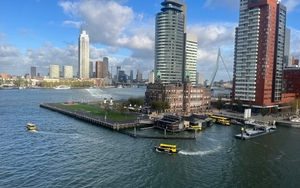Jonathan Schofield discusses the increasing use of in-your-face Cor-Ten steel cladding
It’s a startlingly aggressive addition to the city skyline.
River Street Tower lodged in the armpit of the Mancunian Way and Medlock Street is as tight and disciplined as it would be possible to imagine. It stands as straight as a fully armed Grenadier Guard outside Buckingham Palace.
There's a reason why hard iron and cold steel are never associated with warmth in art or literature.
River Street Tower is tall too at 92m or 302ft, with 792 student residential units over 32 storeys. As with all the towers in this area including the cloud-splitting 201m (659ft) South Tower of Deansgate Square, the architects are Manchester’s own SimpsonHaugh & Partners.
The rigid discipline of the building aside, what passers-by chiefly notice is the use of Cor-Ten steel (strictly speaking COR-TEN but capital letters get too shouty in an article). People will be familiar with this material now, a weathering steel that is low maintenance as it rusts itself into a settled orange.
River Street Tower is now the tallest Cor-Ten clad tower in the UK.
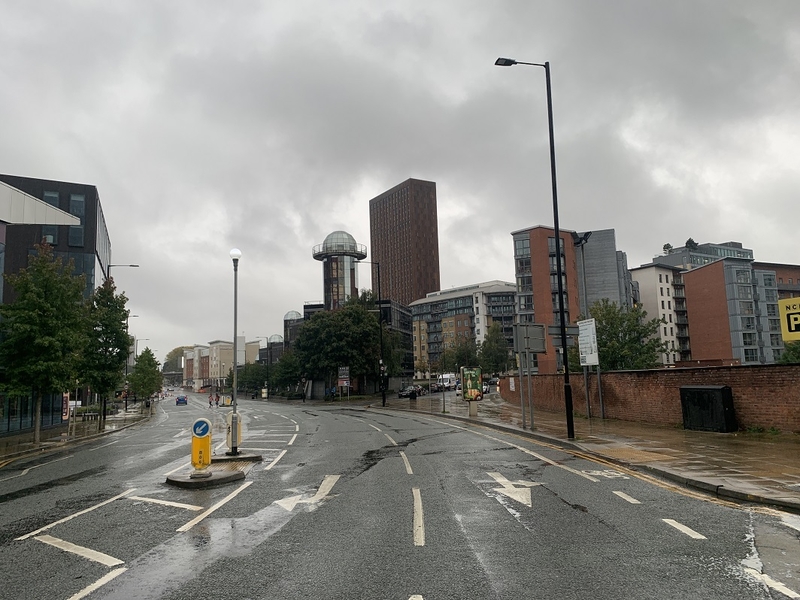
SimpsonHaugh & Partners pioneered the first Manchester building work with this material on Parkway Gate from 2008. This comprises three large student accommodation buildings one of which is again wrapped on three sides with Cor-Ten. The group was starkly impressive then and remains so now. Its highest element is 18 storeys, so River Street is almost twice as high.
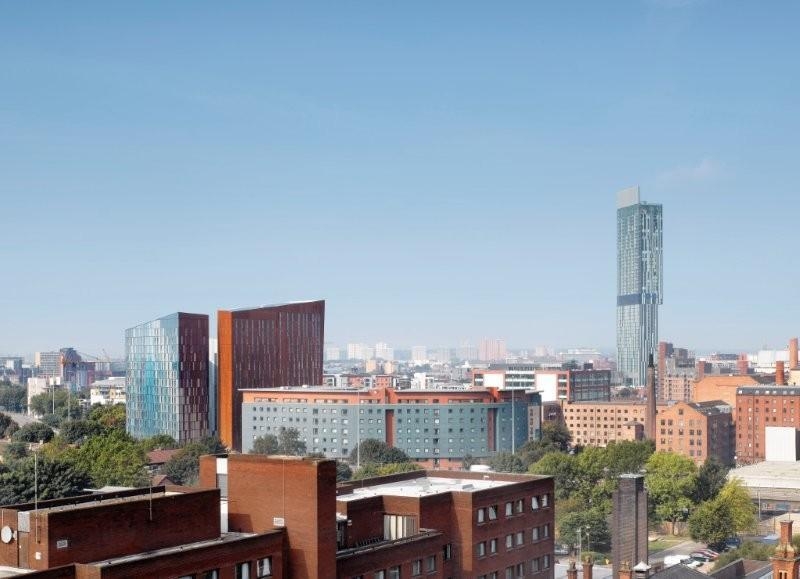
Which brings us to sculpture. And engineering.
Cor-Ten suits both.
The best of the former is the much lamented (well, by me) B of the Bang. The 56m (184ft) sculpture to commemorate the 2002 Commonwealth Games was an airy porcupine by acclaimed designer Tom Heatherwick. The work was a physical expression of athlete Linford Christie's words that he started racing at 'the b of the bang' from the starting pistol. It lasted from 2005 to 2009 and had to be pulled down as its spikes kept working loose and attempting to impale buses on Ashton New Road. Apparently this was deemed a problem.

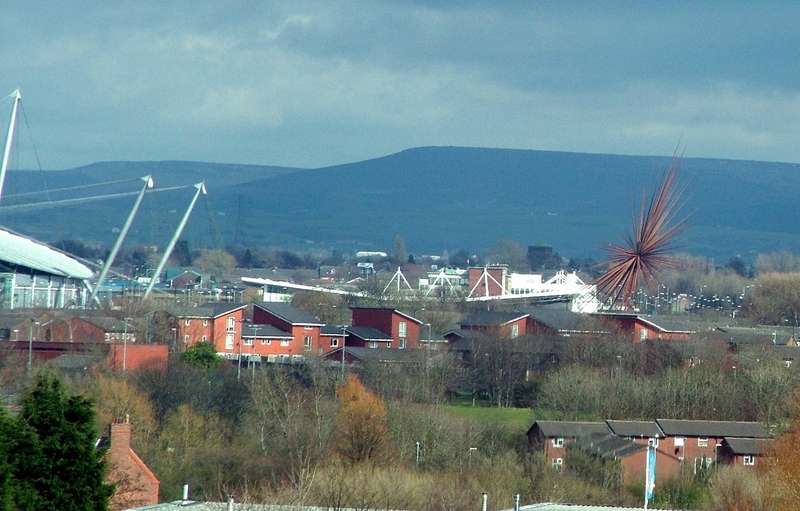
As for engineering sculpture the BDP designed Ordsall Chord railway viaduct from 2017 is a beauty, a glorious Cor-Ten sweep of sensuous steel that gallops across the River Irwell between Manchester and Salford. It’s a shame that B of the Bang had to be destroyed and Ordsall Chord viaduct is shamefully underused.

So does Cor-Ten suit sculpture and engineering better than it does buildings? We asked SimpsonHaugh & Partners for an interview but received no answer.
Dave McCall, architect and co-founder of OMI Architects, was more forthcoming and recalls when he first saw Cor-Ten used for a building.
“It was when I visited the John Deere Headquarters in the 80s when I was studying in Chicago,” says McCall. “William Hewitt, the President of John Deere, wanted Cor-Ten and this was one of the first architectural applications of the material. Designed by Eero Saarinen and finished off by architect Kevin Roche it gave the building the ‘earthy’ look the client wanted as it oxidised and aged.
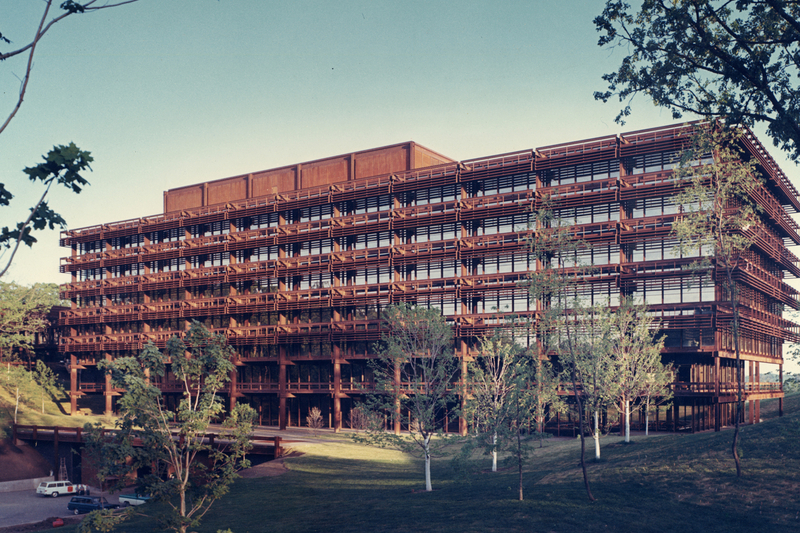
“In this context Cor-Ten was a good choice,” continues McCall. “It allowed the steel structure to be expressed in all its stripped-back beauty and helped bed-in and age the structure, connecting it with the natural elements within the buildings.”
“Moving on to more recent examples,” he says, “Cor-Ten seems to have been adopted simply as a flat cladding panel. This in my opinion undervalues the material and relegates it to lesser (non-structural) materials such as aluminium, glass, etc..."

“For many architects, Cor-Ten holds the same innate attraction as exposed concrete," says McCall. "It has a lot to do with the flexibility and sculptural possibilities of both materials and the absence of any need to apply finishes or protective coatings (making them ‘pure’ in design terms). Walls and roofs can all be formed in a single (apparently) material without any fussy detailing. Cor-Ten arrives on site pre-weathered and immediately has a patina that other materials do not.”
McCall pauses, and wryly adds: “There is of course a point where ‘patina' simply becomes ‘staining’. Cor-ten is clearly in vogue in architectural circles but I doubt whether the public will ever embrace its use just as they never did with exposed concrete.”

Nick Moss, co-founder of SixTwo Architects, and current President of Manchester Society of Architects makes similar points.
“Architects have always had a soft spot for self-weathering steel,” he says. “Maybe because it was first used by engineers and sculptors Cor-Ten gives a confident, quality finish. Perhaps an overused concept, especially in post-industrial cities, it moves in and out of fashion. Often depending on supplier costs. It’s ironic that it can be a relatively expensive material, when the aesthetic is rust.”

Moss considers its use on buildings.
“For me, Cor-Ten works best on smaller projects, contrasted with another material, expressing the beauty and immediate rawness of the finish. I think Hallé St Peters successfully pulls this off. As for towers of the stuff? Why not?”
He agrees completely with Dave McCall on one point however.
“I imagine the brutal application of an entire elevation is not to everyone’s taste, but better that than some of the paper thin cladding we see used elsewhere. Just watch out for the staining.”
Or the patina.

Moss’ point about Cor-Ten being over-used in post-industrial settings is apposite. Let’s take an example within the city
IDP with Oxid House (aka Rust House, I suppose) on Great Ancoats Street write that the building is intended to ‘of course, reference Manchester’s industrial heritage’. Going on about industry is sophistry because there were low shop units on the site before and why not ‘reference’ Manchester’s old Italianate warehouses or Ship Canal-era banks or Gothic civic buildings rather than industry. Manchester has always been much more than industry.
Referencing industry in this city sometimes seems like an excuse to build blandly and cheaply. Oxid House isn't either of these, indeed, I like the building especially the verve with which it hits the ground with that large steel forked column.
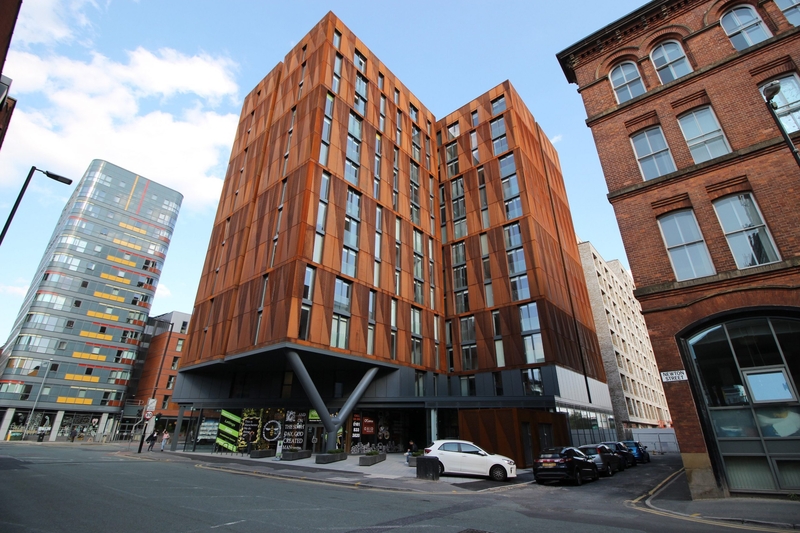
Moss’ other point about Cor-Ten being usually better on smaller buildings is borne out in Manchester.
First, there was The People’s History Museum by Austin Smith: Lord from 2010 and more recently the superb Hallé St Peter’s in Cutting Room Square where the Stephenson Studios extension to the 1859 church matches and merges the russet tones of brick and Cor-Ten with the buildings of Ancoats’ naturally ruddy shade. Hallé St Peters is a a triumph of Cor-Ten, clever, softened by the glass beneath and never too big to overwhelm the older building behind.

Back to River Street Tower.
This is undoubtedly a striking and powerful structure. It’s not all Cor-Ten on the outside, there are dark blue glass panels facing the courtyard and the Mancunian Way. Stained steel was clearly deemed a little too much for the residents in those central areas but why was the building softened to the Mancunian Way? SimpsonHaugh & Partners didn’t respond so we have to make our own minds up.
What the practice has demonstrated is a love for the ‘pure’ aesthetic of the International Modern style, that post-war style of big building as embodied in 1962’s St Andrew’s Tower (now Manchester One) by Leach Rhodes Walker on Portland Street. River Street Tower is their purest version of the International Modern in Manchester yet.
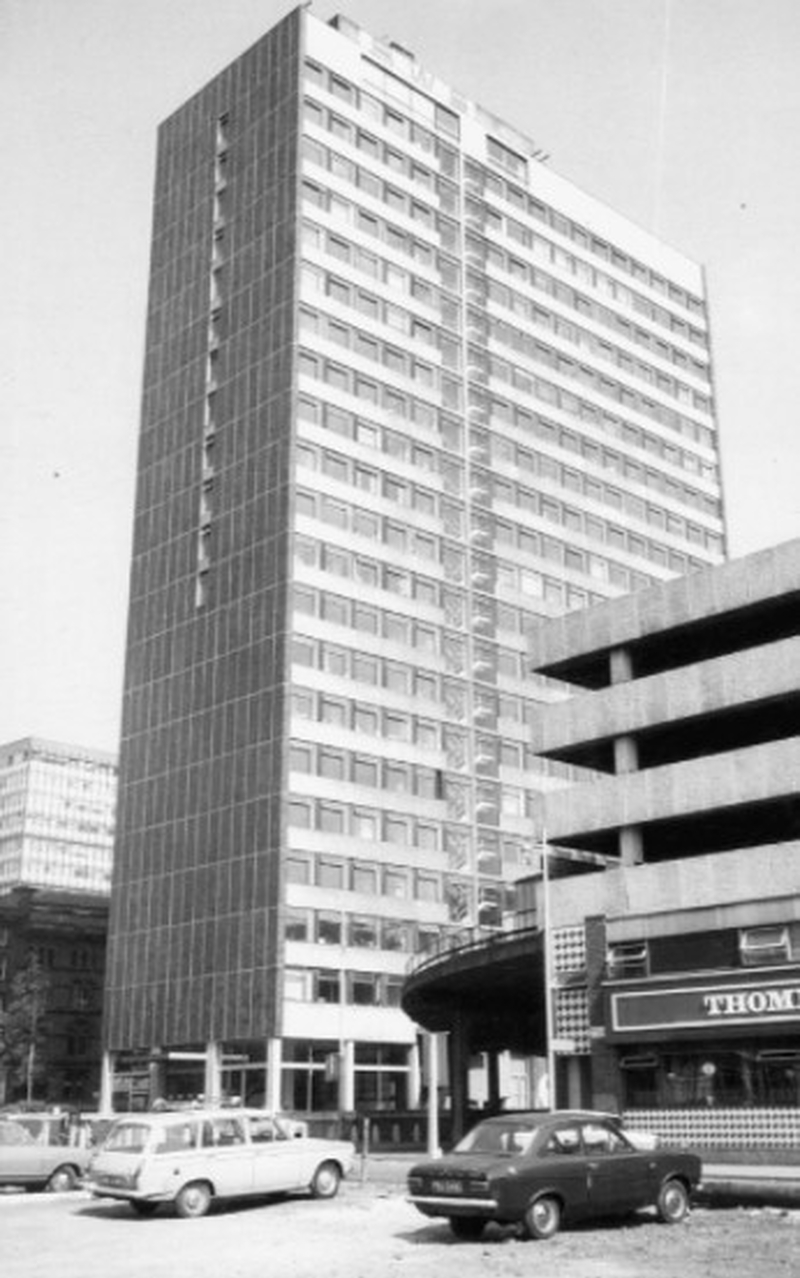
Cor-Ten debates aside, a problem with the building is that River Street Tower somehow feels the wrong way round. The three fang-like concrete columns which face straight on to a Mancunian Way slip road would seem to be the natural place to announce the main entrance, instead the main entrance is on River Street. This is essentially a cave cut in a cliff of Cor-Ten. Next to the entrance some of steel panels seem from a different batch and are weathering in an entirely different way from the main bulk of the panels. That doesn't look right.
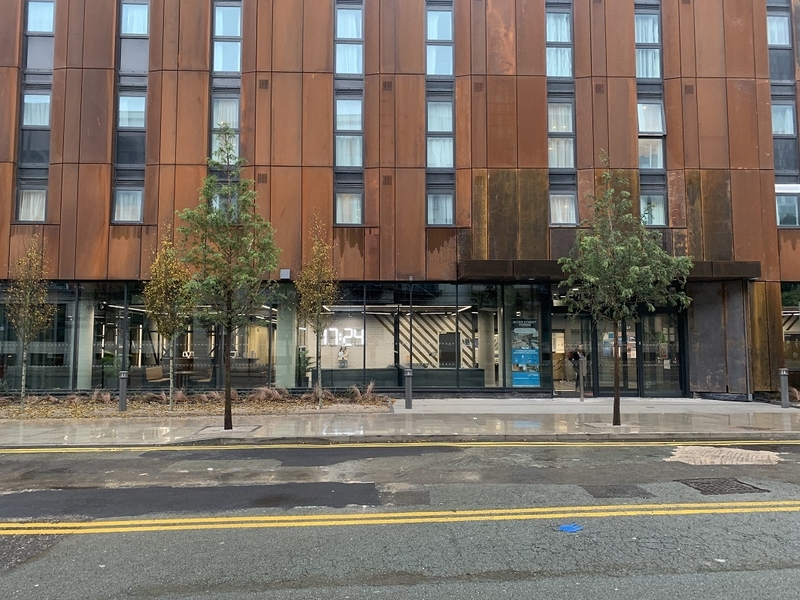

River Street is best admired from a distance. It’s also best admired as a species of tough sculpture (The Angel of the North in Gateshead proved the material’s worth) but not maybe as a place to live. The nearest comparison in the north of England is provided by Fielden Clegg Bradley’s Broadcasting Tower in Leeds. As with River Street Tower this provides student accommodation. It’s an ugly thing though, one feels it’s an experiment that practice will never do again. If you look at Fielden Clegg Bradley’s School of Art in this city yiou wonder what led them to Broadcasting Tower in Leeds.

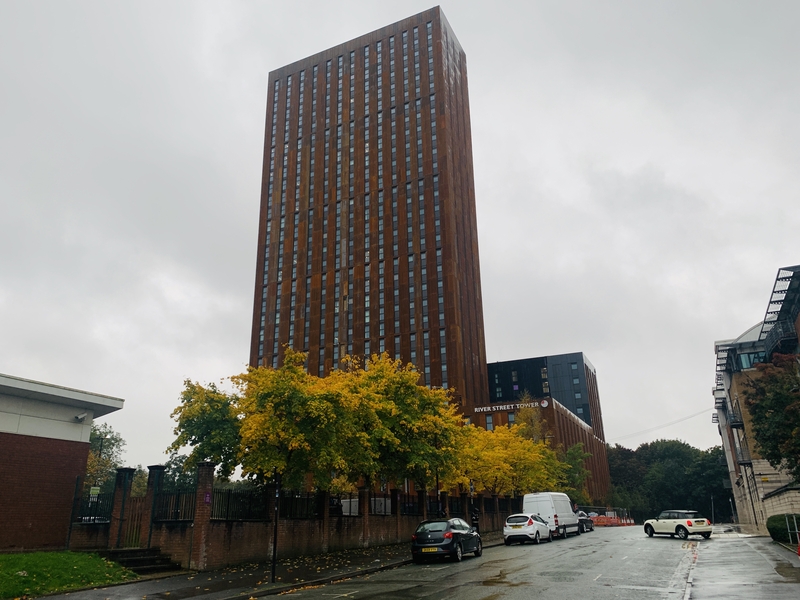
Take a walk round River Street Tower and decide for yourself whether the jury is still out on Cor-Ten clad buildings when used at such a scale. They can be impressive in their discipline but they are also vaguely menacing and always unforgiving. There's a reason why hard iron and cold steel are never associated with warmth in art or literature. You might say River Street Tower wears a steely look.
In the age of Covid-19 the Cor-Ten student towers in Manchester and Leeds also seem perfect metaphors. This is a time when young people in purpose built student accommodation are prevented from leaving their own buildings by security guards. The rise of armour-plated, fortress-like towers is thus apt. A fortress is only a step away from a gaol after all.
SimpsonHaugh & Partners here have put design before people. I am impressed by the building but it feels like an experiment with the way people ‘should’ live their lives or ‘might’ live their lives. It stops me in my tracks but it also makes me ponder the role architects should play in society. Architects want to be deemed artists but they are businesses first and foremost. Good on them for that, just don’t don’t cloud it in clever language that disguises the profit motive.
Or maybe I am wrong and architects are the most compromised of creatives. They have to build beauty in a landscape of narrow margins. They are never ‘free’ in the way a novelist or painter may be. Yet the good architects are special because they make our walk around a city more interesting, distinctive.
So, I have to finish by praising SimpsonHaugh & Partners. Manchester’s architectural community compared to that in other UK cities is a jewel. There are so many ideas going on that it is clear we won’t agree with them all.
I walk around 2020 Manchester/Salford and I recall decayed 1988 Manchester and I think is there in these four square miles anywhere more interesting in terms of movement in Europe? We’ll find out whether that’s for better or worse in a decade or so.










